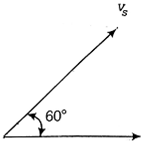 Multiple Choice Questions
Multiple Choice QuestionsOut of the following options which one can be used to produce a propagating electromagnetic wave?
A stationary charge
A chargeless particle
An accelerating charge
An accelerating charge
A train moving t a speed of 220 ms-1 towards a stationary object. emits a sound of frequency 1000 Hz. Some of the sound reaching the object gets reflected back to the train as echo. The frequency of the echo as detected by the driver of the train is
(speed of sound in air is 330 ms-1)
3500 Hz
4000 Hz
5000 Hz
5000 Hz
A speeding motorcyclist sees traffic jam ahead of him. He slows down to 36 km/hr. He finds that traffic has eased and a car moving ahead of him at 18 km/hr is honking at a frequency of 1392 Hz. If the speed of sound is 343 m/s, the frequency of the honk as heard by him will be,
1332 Hz
1372 Hz
1412 Hz
1412 Hz
Two waves are represented by the equations,![]() m where x is in metre and t in second. The phase difference between them is
m where x is in metre and t in second. The phase difference between them is
1.25 rad
1.57 rad
0.57 rad
0.57 rad
Sound waves travel at 350 m/s through a warm air and at 3500 m/s through brass. The wavelength of a 700 Hz acoustic wave as it enters brass from warm air.
increases by a factor 20
increases by a factor 10
decreases by a factor 20
decreases by a factor 20
Light of two different frequencies whose photons have energies 1 eV and 2.5 eV respectively illuminate a metallic surface whose work function is 0.5 eV successively. Ratio of maximum speeds of emitted electrons will be
1:2
1:4
1:5
1:5
A source of sound S emitting waves of frequency 100 Hz and an observer O are located at some distance from each other. The source is moving with a speed of 19.4 ms-1 at an angle of 60o with the source observer is at rest. the apparent frequency observed by the observer (velocity of sound in air 330 ms-1) is 
100 Hz
103 Hz
106 Hz
106 Hz
A transverse wave os represented by y = A sin (ωt - kx). For what value of the wavelength is the wave velocity equal to the maximum particle velocity?
π A /2
π A
2πA
2πA
A tuning fork of frequency 512 Hz makes 4 beats/s with the vibrating string of a piano. The beat frequency decreases to 2 beats/s when the tension in the piano string is slightly increased. The frequency of the piano string before increasing the tension was.
510 Hz
514 Hz
516 Hz
516 Hz
A wave in a string has an amplitude of 2 cm. The wave travels in the +ve direction of x -axis with a speed of 128 ms-1 and it is noted that 5 complete waves fit in 4 m length of the string. The equation describing the wave is
y = (0.02) m sin (7.85 x +1005t)
y = (0.02) m sin (15.7 x -2010t)
y = (0.02) m sin (15.7 x + 2010t)
y = (0.02) m sin (15.7 x + 2010t)
